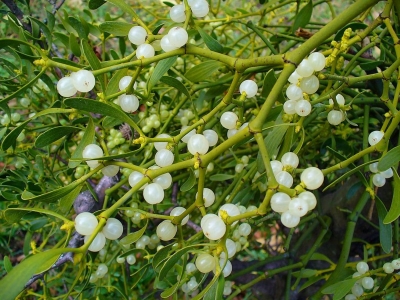
This evergreen plant is a parasite, growing on the branches of various forest and fruit trees. Mistletoe was sacred to the people of ancient Europe. Druids it in their sacrifices and the celts believed had magical and healing powers.
European mistletoe (Viscum album), the traditional mistletoe of literature and Christmas celebrations, was known for centuries before the Christian era. It is distributed throughout Eurasia from Great Britain to northern Asia. It forms a drooping yellowish evergreen bush, 60–90 cm (2–3 feet) long, on the branch of a host tree. It has thickly crowded forking branches with oval to lance-shaped leathery leaves about 5 cm (2 inches) long, arranged in pairs, each opposite the other on the branch. The flowers, in compact spikes, are bisexual or unisexual and have regular symmetry. They are yellower than the leaves, appear in late winter, and soon give rise to one-seeded white berries, which when ripe are filled with a sticky semitransparent pulp. These berries, and those of other mistletoes, contain toxic compounds poisonous to many animals and to humans. The European mistletoe is most abundant on apple trees, poplars, willows, lindens, and hawthorns. Its North American counterpart, the Eastern, or oak, mistletoe (Phoradendron serotinum), also parasitizes many deciduous trees, including oaks.
Credit : Britannica
Picture Credit : Google




